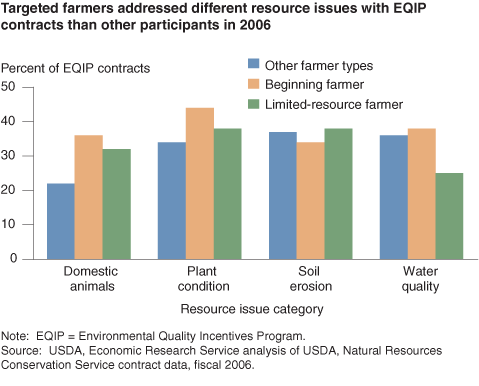Targeted Farmers in EQIP Operate More Environmentally Sensitive Land, But Address Different Environmental Needs
- by Michael S. Hand and Cynthia Nickerson
- 9/1/2010
Farm legislation in 2002 and 2008 contained provisions to encourage participation in USDA’s Environmental Quality Incentives Program (EQIP) by beginning, limited-resource, and socially disadvantaged farm operators. These “targeted farmers” have not enrolled in Government agricultural programs at the same rate as other farmers.
To encourage participation, EQIP provides more favorable payment (higher cost share) and enrollment terms for targeted farmers than for other EQIP farmers. If targeted farmers address different environmental needs or operate acreage that is more or less environmentally sensitive than land operated by other EQIP farmers, the EQIP provisions favorable to targeted farmers could change the economic and environmental outcomes of the program. In the Delta region, for example, beginning farmers in EQIP were located in areas with significantly more highly erodible cropland than other EQIP farms in the region, and both beginning and limited-resource EQIP farmers were located closer, on average, to impaired waterways. Encouraging these targeted farmers to participate may increase EQIP’s potential environmental benefits.
Based on EQIP program data from 2006, targeted farmers (excluding socially disadvantaged farmers since they were not identified in EQIP prior to 2008), on average, also appear to concentrate on different resource issues than other participants. Compared with other farmers, beginning and limited-resource farmers are more likely to adopt practices that address domestic animal forage and plant productivity issues. Other farmers are more likely to address soil erosion and water quality issues. Targeted farmers also tend to address multiple resource concerns and use a combination of management practices and structural investments. Management practices can include changing tillage practices on cropland or using prescribed grazing on rangeland; structural investments can include fencing or improvements to irrigation equipment.
Encouraging beginning farmers with more environmentally sensitive land to participate in EQIP may mean greater potential environmental benefits, but at a greater cost. Beginning farmers in EQIP received larger payments per conservation practice than other farmers and other disadvantaged farmers, because the beginning farmers receive cost-share rates up to 25 percent higher than would otherwise be applicable, resulting in higher total payments per contract on average. Beginning farmers treated fewer acres and installed smaller structural conservation practices than other EQIP farmers but were likely to install more practices as part of each EQIP contract.
Limited-resource farmers tend to install smaller conservation practices in EQIP than other farmers, and total conservation payments to limited resource farmers were lower on average. Limited-resource farmers in EQIP may operate land that can generate larger environmental benefits, but they make smaller conservation investments at a lower total cost per contract.
This article is drawn from:
- Nickerson, C. & Hand, M.S. (2009). Participation in Conservation Programs by Targeted Farmers: Beginning, Limited-Resource, and Socially Disadvantaged Operators' Enrollment Trends. U.S. Department of Agriculture, Economic Research Service. EIB-62.


